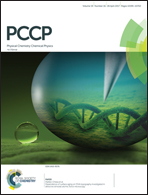Hexacyanometallates for sodium-ion batteries: insights into higher redox potentials using d electronic spin configurations†
Abstract
A fundamental understanding of anomalous redox mechanisms in hexacyanometallate compounds, compared with conventional NaMO2 systems (M: transition metals), is presented based on first-principles calculations and experimental validations. From theoretical calculations, we identified low-spin and high-spin states of Fe ions coordinated by the cyanide group (–CN) with the same oxidation state (Fe2+) in Na2Fe2(CN)6. Considering the site dependency of d electronic spin configurations based on the crystal field theory (CFT) of transition metals (TMs), we calculated the thermodynamic mixing energy using Na2Fe2(CN)6 and Na2Mn2(CN)6 for obtaining a thermodynamically stable phase of Na2FeMn(CN)6. The phase stabilities of Na2Fe2−xMnx(CN)6 among many atomic configurations and lattice parameters originating from octahedral structures (i.e., Fe(CN)6 and Mn(NC)6) are highly dependent on the electronic structures of TMs with spin states. From partial density of states (PDOS) and spatial electron distributions, it was observed that Fe2+ in the low-spin state (t62g) and Mn2+ in the high-spin states (t32g and e2g) in the stable phase lead to higher redox potentials (∼3.55 V vs. Na/Na+) with the removal of Na+ as compared to that of Na2Fe2(CN)6. In addition, lattice parameters from x = 0 to x = 1 in Na2Fe2−xMnx(CN)6 are increased due to the larger ionic radius of Mn2+ in the high-spin states. On the other hand, Fe2+ in the high-spin states (t42g and e2g) and Mn2+ in the low-spin state (t52g) in the most unstable phase of Na2FeMn(CN)6 would have lower redox potentials. Based on the fundamental correlation between redox potentials and CFT with spin configurations of TMs, we suggest a material design concept for intercalation compounds with higher energy densities for rechargeable battery systems.



 Please wait while we load your content...
Please wait while we load your content...